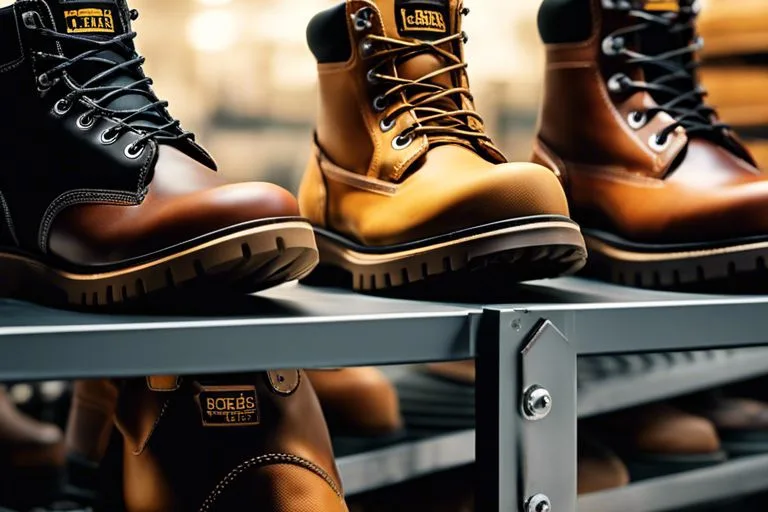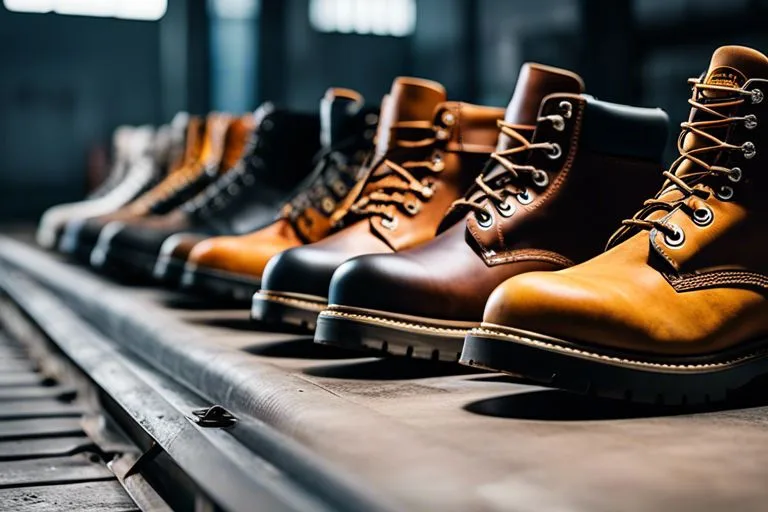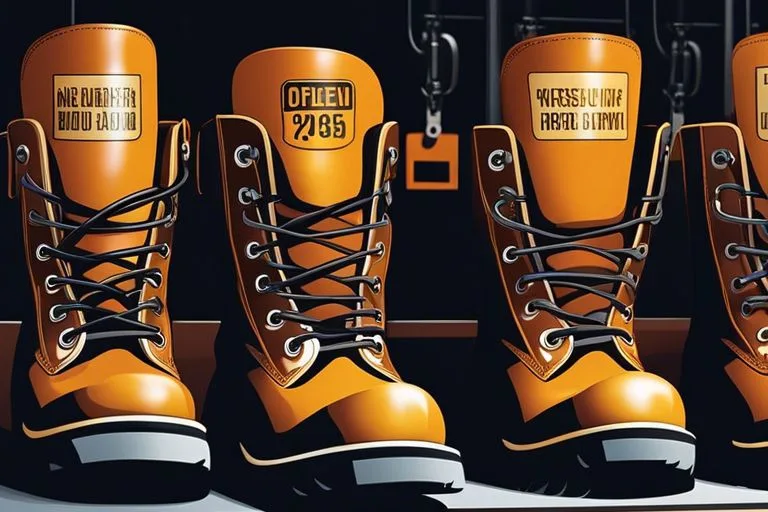When it comes to protecting your feet on the job, safety ratings for men’s work boots are crucial to ensuring you have the proper protection in place. With so many options on the market, it can be daunting to navigate the world of work boots and decipher what each safety rating means for your safety on the job. That’s why we’re here to provide you with a comprehensive guide to understanding safety ratings for men’s work boots and help you make an informed decision when it comes to selecting the right pair for your needs.
When it comes to work boots, safety should always be your top priority. The wrong pair of boots could leave you vulnerable to a range of hazards on the job, from slip and fall accidents to impact injuries. By understanding the various safety ratings available, you can ensure that you have the proper level of protection for your specific work environment. So, let’s dive in and navigate the world of men’s work boots with safety ratings.
Understanding Safety Ratings
Before you start shopping for men’s work boots, it’s important to understand the safety ratings that are associated with them. These ratings are crucial in ensuring that you have the right level of protection for your specific work environment. By understanding safety ratings, you can make a more informed decision when choosing the right pair of work boots for your needs.
Breakdown of Safety Rating Systems
When it comes to safety ratings for work boots, there are different systems in place to help you understand the level of protection they offer. The most common safety rating systems include the ASTM (American Society for Testing and Materials) and the ANSI (American National Standards Institute) ratings. Each rating system has its own set of standards and criteria that work boots must meet in order to be certified. This helps ensure that the boots provide the level of protection needed for specific work environments.
Interpreting Safety Standards and Certifications
Interpreting safety standards and certifications can be confusing, but it’s important to understand what they mean when shopping for work boots. ASTM and ANSI safety ratings typically include information on impact resistance, compression resistance, puncture resistance, and electrical hazard protection. By understanding these standards and certifications, you can ensure that you’re getting the right level of protection for your specific work environment. It’s important to pay attention to the details and look for safety ratings that meet or exceed the requirements for your job. Choosing work boots that meet the highest safety standards can help protect you from potential hazards and prevent serious injuries.

Types of Men’s Work Boots
Obviously, when it comes to men’s work boots, there are several different types to choose from, each with its own purpose and features. Here is a breakdown of the various types of men’s work boots that you may encounter:
- Steel toe boots – provide protection for your toes from heavy objects and are typically required in many work environments.
- Composite toe boots – offer similar protection to steel toe boots, but are made from non-metal materials, making them lighter and more comfortable to wear.
- Waterproof and insulated boots – designed to keep your feet dry and warm in wet and cold conditions.
- Electrical hazard rated boots – provide protection against electrical accidents by insulating your feet from electric shocks.
- Slip-resistant and puncture-resistant boots – help prevent slips and falls, as well as protect your feet from sharp objects or punctures.
Assume that each type of men’s work boot offers different levels of protection and features, so it’s important to consider your specific needs when choosing the right pair for you.
Steel Toe vs. Composite Toe Boots
When it comes to choosing between steel toe boots and composite toe boots, it’s important to consider the level of protection you need and your comfort. Steel toe boots are highly durable and provide maximum protection against heavy objects, but they can be heavy and uncomfortable to wear for long periods. On the other hand, composite toe boots offer similar protection while being lighter and more comfortable, making them a great choice for those who need to be on their feet all day.
Waterproof and Insulated Work Boots
When working in wet or cold conditions, waterproof and insulated work boots are essential for keeping your feet dry and warm. These boots are typically made with waterproof materials and feature insulation to provide warmth in low temperatures, ensuring that you can work comfortably and safely in challenging environments.
Electrical Hazard Rated Boots
If you work in an environment with electrical hazards, such as construction sites or industrial facilities, electrical hazard rated boots are crucial for protecting you from electric shocks. These boots are specially designed to insulate your feet from electrical currents, reducing the risk of serious injury or fatality in the event of an electrical accident.
Slip-Resistant and Puncture-Resistant Boots
For added safety in slippery or hazardous work environments, slip-resistant and puncture-resistant boots are essential. These boots are designed with specialized outsoles to provide traction and stability on slippery surfaces, as well as features to protect your feet from puncture wounds caused by sharp objects or materials. Investing in these boots can greatly reduce the risk of slips, falls, and foot injuries in your workplace.
Work Boot Features and Materials
However, before you start shopping for a pair of men’s work boots, it’s important to understand the various features and materials available. The type of work boot you choose will depend on your specific needs, so it’s essential to consider the different options carefully. For a comprehensive guide to the best work boots, you can check out this resource for Best Work Boots 2023 | Most Comfortable Boots for Men.
Leather, Synthetic, and Mixed Material Options
When it comes to work boot materials, you have several options to choose from. Leather work boots are known for their durability and water resistance, making them a popular choice for many workers. Synthetic materials, on the other hand, can offer lightweight and breathable options. Mixed material boots combine the best of both worlds, providing a balance of durability and comfort.
Durability and Longevity Considerations
When investing in a pair of men’s work boots, durability and longevity are crucial factors to consider. You want a pair of boots that can withstand the wear and tear of your work environment and last for an extended period. Look for features such as reinforced toe caps, strong stitching, and quality materials to ensure the longevity of your work boots. Remember, a durable pair of work boots can protect you from potential hazards and keep you safe on the job.
Comfort Features and Ergonomic Design
Aside from safety, it’s essential to prioritize comfort when selecting work boots. Long hours on your feet can take a toll on your body, so choosing boots with ergonomic design and comfort features is crucial. Look for cushioned insoles, arch support, and breathable linings to ensure that your boots provide the necessary comfort for your workday. Comfortable work boots can reduce fatigue and improve your overall productivity on the job.
Industry-Specific Work Boot Recommendations
Now that you have a good understanding of safety ratings for work boots, it’s time to delve into industry-specific recommendations. Keep in mind that different work environments require different types of protection, so it’s important to choose the right pair of boots for your specific job.
Work Boots for Construction and Heavy Industry
When working in construction or heavy industry, you are often exposed to various hazards such as heavy machinery, sharp objects, and uneven terrain. You need a pair of work boots that can provide maximum protection and support. Look for boots with steel toe or composite toe construction to protect your feet from falling objects or compression injuries. Additionally, slip-resistant outsoles are crucial for providing traction and stability on slippery surfaces. A shock-absorbing midsole can also help reduce the impact of walking or standing on hard surfaces for long periods.
Footwear for Electricians and Utility Workers
If you are an electrician or utility worker, you need work boots that prioritize electrical hazard protection. Look for boots with EH (Electrical Hazard) ratings, which means they are designed to provide a secondary source of protection against electrical hazards. In addition to EH ratings, consider boots with metatarsal guards to protect the top of your feet from impact and compression injuries. A non-conductive outsole is also essential to minimize the risk of electrical shock when working around live wires.
Specialized Boots for Chemical and Hazardous Environments
For those working in chemical and hazardous environments, it’s crucial to prioritize protection against chemical spills and exposure. Look for work boots with chemical-resistant materials to protect your feet from corrosive substances. Boots with liquid-proof construction and seam-sealed technology can prevent hazardous chemicals from seeping into your boots. Additionally, acid-resistant outsoles can provide the necessary traction and protection when working with corrosive substances. Remember to check for specific safety standards and certifications related to chemical resistance when choosing boots for this type of environment.
Maintenance and Care of Work Boots
To ensure that your work boots last as long as possible and continue to provide the protection you need, it’s important to take proper care of them. This involves regular cleaning, conditioning, and storage. Following these maintenance tips will not only extend the life of your boots, but also ensure that they continue to meet safety standards.
Cleaning and Conditioning for Extended Boot Life
Regular cleaning and conditioning are essential for keeping your work boots in good condition. To clean them, remove any excess dirt or debris with a brush or damp cloth. For conditioning, use a high-quality leather conditioner to keep the leather supple and prevent it from drying out and cracking. You can find more information about the best leather conditioners in this article on USA Work Boot Quality: The Best American-Made Boots.
Storage Tips to Preserve Boot Integrity
Proper storage is crucial for preserving the integrity of your work boots. When you’re not wearing them, store them in a cool, dry place away from direct sunlight and heat sources. If possible, use a boot tree or stuffing to help them maintain their shape. Additionally, consider storing them in a breathable bag or box to protect them from dust and moisture. Keeping your boots well-maintained and properly stored will ensure they are always ready for use when you need them.
- Store your boots in a cool, dry place away from direct sunlight and heat sources.
- Use a boot tree or stuffing to help maintain the shape of your boots.
- Consider storing them in a breathable bag or box to protect them from dust and moisture.
When to Replace Your Safety Footwear
Despite your best efforts, there will come a time when your work boots need to be replaced. It’s important to know when this time has come, as wearing worn-out boots can compromise your safety. Inspect your boots regularly for signs of wear and tear, including cracked leather, worn-out soles, and deteriorating safety features. If the boots no longer provide adequate protection, it’s time to invest in a new pair. After all, your safety is worth the investment.
Purchasing Guide for Men’s Work Boots
After reading about different industries and the best boots for each, it’s now time to figure out which work boots are the best fit for you. The Best Boots for Different Industries: A Guide for Workers can help you understand the specific boot requirements for your line of work. Now, let’s delve into some important considerations to make when purchasing men’s work boots.
Assessing Workplace Hazards and Boot Requirements
When it comes to selecting the right pair of work boots, it’s crucial to assess the specific hazards present in your workplace. Consider the types of materials, equipment, and environmental factors that could pose a threat to your feet. For example, if you work in a construction site, you’ll need boots with heavy-duty protection against punctures, while those working with chemicals may need boots with chemical-resistant materials. Understanding your workplace hazards will help you identify the safety features you need in a pair of work boots.
Considerations for Fit, Comfort, and Size
Ensuring that your work boots provide a proper fit and comfortable feel is essential for maintaining safety and productivity on the job. Ill-fitting boots can cause discomfort, blisters, and even lead to trips or falls. Look for work boots with ample cushioning, supportive insoles, and breathable materials to keep your feet comfortable during long hours on the job. Additionally, make sure to measure your feet accurately to select the right size, taking into account any extra space needed for thick socks or foot swelling throughout the day.
Value vs. Cost: Balancing Budget and Safety
When purchasing work boots, it’s important to strike a balance between value and cost. While it can be tempting to opt for the most affordable option, this could compromise the safety and durability of the boots. Remember, investing in a high-quality pair of work boots is an investment in your safety and well-being. Look for boots with reinforced toe caps, slip-resistant outsoles, and durable construction to ensure they can withstand the rigors of your work environment. Remember, paying a bit more for superior protection and longevity can save you from potential injuries and frequent replacements in the long run.

Conclusion: Safety First – Navigating the World of Men’s Work Boots with Safety Ratings
So, as you can see, understanding the safety ratings and features of men’s work boots is essential for ensuring your protection and comfort in a variety of work environments. By paying attention to key safety elements such as electrical hazard protection, slip resistance, and toe protection, you can make a well-informed decision when selecting the right work boots for your needs. Additionally, by staying informed about the latest safety standards and regulations, you can better navigate the vast array of options available to you, and ultimately prioritize your safety on the job.
Remember, your safety is of the utmost importance, and by investing in high-quality work boots with appropriate safety ratings, you can minimize the risk of injury and ensure a more secure and enjoyable work experience. So, take the time to research and compare different safety ratings and features before making a purchase, and prioritize your safety first when it comes to choosing the right men’s work boots for your specific needs.
FAQ
Q: What are safety ratings for men’s work boots?
A: Safety ratings for men’s work boots indicate the level of protection the boots offer against various workplace hazards, such as impact, compression, puncture, and electrical hazards.
Q: What is the importance of safety ratings in men’s work boots?
A: Safety ratings in men’s work boots are important for ensuring the safety and well-being of the wearer in hazardous work environments. They help employers and workers make informed decisions about the appropriate footwear for specific job requirements.
Q: How do safety ratings affect the durability of men’s work boots?
A: Safety ratings can affect the durability of men’s work boots by influencing the materials and construction used in the boots. Higher safety ratings often require stronger materials and more robust construction, leading to increased durability.
Q: What are some of the common safety standards for men’s work boots?
A: Common safety standards for men’s work boots include ASTM (American Society for Testing and Materials) and ANSI (American National Standards Institute) standards, which establish criteria for protective footwear in various industries.
Q: How can I ensure that my men’s work boots meet the necessary safety ratings?
A: To ensure that your men’s work boots meet the necessary safety ratings, look for labels or markings indicating compliance with relevant safety standards. Additionally, consider consulting with a safety professional or footwear specialist to determine the most suitable safety ratings for your specific work environment.

